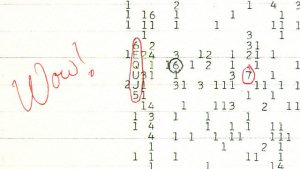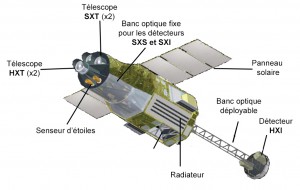Author: Randy Graham
Repelling Mosquitoes. Or Not.
So all those gadgets and candles you use for getting rid of mosquitoes? Mostly worthless, it seems.
A large number of different spray-on repellents and wearable repellent devices are commercially available. The efficacies of many repellents are unknown. This study focuses on the efficacy of eleven different repellents in reducing the number of Ae. aegypti female mosquitoes attracted to human bait. We performed attraction-inhibition assays using a taxis cage in a wind tunnel setting. One person was placed upwind of the taxis cage and the mosquito movement towards or away from the person was recorded. The person was treated with various spray-on repellents or equipped with different mosquito repellent devices.
The most effective repellent was a DEET-based product. And least effective were devices which use high-frequency sound to keep mosquitoes away. Link found via ScienceMag.
Make Science for All
For the next few weeks, you have the opportunity to contribute to NOVA and David Pogue on their  Kickstarter project NOVA: Make Science for All. I’m a big fan of Kickstarter, and have been supporting projects through crowdfunding on the site for years now. This particular project is obviously something I especially support at Little Bits of Science. While I’m currently only donating at the “Download the Special” level, I’m considering increasing my contribution to the “Pay It Forward: Adopt A Teacher” level and sending the disc media to one of my childrens’ teachers.
Kickstarter project NOVA: Make Science for All. I’m a big fan of Kickstarter, and have been supporting projects through crowdfunding on the site for years now. This particular project is obviously something I especially support at Little Bits of Science. While I’m currently only donating at the “Download the Special” level, I’m considering increasing my contribution to the “Pay It Forward: Adopt A Teacher” level and sending the disc media to one of my childrens’ teachers.
Please check out this important Kickstarter project and support science for the world at large.
The Wow! Signal
Proving that there is still much about the universe we don’t know, the Wow! signal from 1977 confounds to this day. So what is the Wow! signal, and why is it still of interest roughly 40 years later?
the universe we don’t know, the Wow! signal from 1977 confounds to this day. So what is the Wow! signal, and why is it still of interest roughly 40 years later?
Should another civilization somewhere in the universe want to communicate with us and announced their presence, it is theorized that these alien beings will most likely broadcast at 1420 megahertz (MHz), a natural emission frequency of hydrogen. The thinking is that given hydrogen’s natural abundance in the universe, all intelligent creatures will be aware of it and therefore attempt to communicate at this natural emission line. So back in the 1970s, when Ohio State University was re-purposing the Big Ear telescope in Delaware, Ohio to help with SETI, the telescope was tuned to watch the 1420 MHz frequency.
Big Ear was set to scan the sky in 72 second intervals, changing locations scanned after that time due to the earth’s rotation. The signal was only heard on a single frequency with no accompanying static on surrounding frequencies. A signal created from something in nature would normally be expected to have static along with the signal.
The signal also “rose and fell” during the 72 seconds, as would be expected from something originating in space. When the radio telescope is pointed at the sky, any such signal will appear to increase in intensity as it first moves across the observational beam of the telescope, then peak when the telescope is pointed straight at it and then decrease as it moves away from the telescope. This also makes a mere computer glitch a less likely explanation, although not impossible.
Subsequent checks in the same approximate area for additional signals have turned up nothing. So we haven’t seen anything that helps us determine for certain if this is a natural “noise” from elsewhere in the universe or if it was created by another intelligent species.
However, recently Professor Antonio Paris of St. Petersberg College in Florida has put forward a hypothesis as to what the Wow! signal really is. He believes it could have been reflections from one of two comets believed to be in the area of the Big Ear’s orientation back in 1977. And he’s crowdfunding the money needed to test his hypothesis.
Comet 266P/Christensen will pass the Chi Sagittarii star group again on 25 January 2017, while 335P/Gibbs will make its passage on 7 January 2018. Paris plans to observe these events to look for a recurrence of the mystery signal. But time is not on his side for using an existing radio telescope – they are all booked out.
So by this time next year we should be able to tell if Professor Paris is right or not. Look for a follow-up then. In the meantime, if you’d like to hear more about the Wow! signal, I recommend a read or listen to the Skeptoid Wow! episode which better covers much of what we know or think we know about the signal.
No, we haven’t found an alien mega-structure yet
Over a year ago, scientists announced that  they were baffled by the apparent dimming of star KIC8462852, also known as Tabby’s star. Now this is not a newly discovered star, but rather one that has been known for well over a hundred years. And that age of the star is part of what contributes to the mystery around it. See, when the star was first discovered, it was brighter than it is now. And while that isn’t unusual for a young star, KIC8462852 is understood to be a mature star – a definition that varies according to how massive the star is, but is generally millions or even billions of years.
they were baffled by the apparent dimming of star KIC8462852, also known as Tabby’s star. Now this is not a newly discovered star, but rather one that has been known for well over a hundred years. And that age of the star is part of what contributes to the mystery around it. See, when the star was first discovered, it was brighter than it is now. And while that isn’t unusual for a young star, KIC8462852 is understood to be a mature star – a definition that varies according to how massive the star is, but is generally millions or even billions of years.
Of course, the intarwebz came to the rescue of these poor researchers, putting forward the inescapable  conclusion that what we were seeing was evidence of an alien mega-structure, most likely a Dyson Sphere. That is to say, the popular opinion online has been that the light from the star is blocked periodically by a partially built structure which surrounds star KIC8462852 and harnesses much/most of the energy output of the star, converting it to some other energy form for the advanced technology built by the aliens living near the star. Naturally, there is no other possible explanation, and clearly we’ve finally found evidence of other life in the universe.
conclusion that what we were seeing was evidence of an alien mega-structure, most likely a Dyson Sphere. That is to say, the popular opinion online has been that the light from the star is blocked periodically by a partially built structure which surrounds star KIC8462852 and harnesses much/most of the energy output of the star, converting it to some other energy form for the advanced technology built by the aliens living near the star. Naturally, there is no other possible explanation, and clearly we’ve finally found evidence of other life in the universe.
The so-called alien megastructure hypothesis persisted longer than most extra-terrestrial-based theories, simply because scientists had few alternative ideas to explain the star’s peculiar blinking – until now. And the latest theory is almost as intriguing as the alien hypothesis.
Except, of course, that’s likely not what we’re seeing. The prevailing opinion now among experts is that we were witnessing the tail end of KIC8462852 consuming one of its own planets, brightening as a result of the added fuel, and slowly dimming back to its natural magnitude over the past hundreds or maybe thousands of years.
If KIC 8462852 did eat a planet – which is extremely rare in the space world, unless a collision pushed the planet out of its orbit – the star’s brightness would increase for a short period of 200 to 10,000 years as it burned up the planet (short in star time, that is). But once the burning was complete, the star would go back to around its original level of brightness.
So while the Dyson Sphere hypothesis is more fun, the more likely explanation is still fascinating, and gives us more information towards building a better understanding of our universe.
And Hitomi is Gone Again. For Good.
So just after I made the last post about a potential save of the Hitomi X-ray telescope, news comes that the satellite is gone for good this time. Due to a software error, the telescope was sent spinning out of control until it basically tore itself apart. Sadly, this 10-year planned mission ended up giving only a few days of data collection.
At 3:01 a.m. Japan time on March 26, the spacecraft began a preprogrammed manoeuvre to swivel from looking at the Crab Nebula to the galaxy Markarian 205. Somewhere along the way, the problems with the star tracker caused Hitomi to rely instead on another method, a set of gyroscopes, to calculate its orientation in space. But those gyroscopes were reporting, erroneously, that the spacecraft was rotating at a rate of about 20 degrees each hour. Tiny motors known as reaction wheels began to turn to counteract the supposed rotation.
Hearing from Hitomi Again!
So earlier in the life of Little Bits of Science, I wrote about the Hitomi satellite, at the time apparently lost in space. It turns out that the day after I wrote about it, Hitomi was heard from again!
Junked? Maybe not. Hitomi, a Japanese astronomy satellite, was thought to be lost after it failed to come online. Now the Japanese Aerospace Exploration Agency says the satellite has phoned home – but a full recovery will take months.
What does this mean, exactly? Well, it’s too early to say, even now a month since we’ve heard from the satellite. According to communication that scientists have since gathered from Hitomi – infrequent beacon signals which have been picked up – it appears the satellite is still there, just spinning out of control. And apparently, this is a recoverable situation. The Japanese space agency responsible for the satellite is working on restoring communication and stabilizing it so Hitomi can return to its mission of X-Ray observation of the universe.
Bees are Addicted to Caffeine
I’m a big fan of caffeine. So much so that I have a caffeine molecule tattooed on my left forearm.  But it turns out that humans aren’t the only caffeine aficionados. Bees like caffeine, and spend more time gathering nectar from flowers which naturally produce caffeine.
But it turns out that humans aren’t the only caffeine aficionados. Bees like caffeine, and spend more time gathering nectar from flowers which naturally produce caffeine.
Scientists at the University of Sussex said they thought the plants produce the caffeine in their nectar to fool bees into thinking it contains more sugar than it actually does. The insects will repeatedly visit those flowers, helping the plants maximize pollination.
Francis Ratnieks, a professor of apiculture at the university, said bees communicate by moving their abdomens a certain way — or, as he calls it, “dancing.” He said the caffeine increases that dancing.
Photo by paulscott56 
What Happened to the Hitomi Telescope?
Launched on February 17th, the Hitomi telescope is an X-Ray telescope commissioned by the Japanese Aerospace Exploration Agency (JAXA). While everything looked fine for the telescope during testing done since launch,  when it was time to power up for real work this past Sunday, the satellite was strangely quiet.
when it was time to power up for real work this past Sunday, the satellite was strangely quiet.
Engineers have been unable to determine the health of the satellite since the sudden disruption in communications, JAXA said, although ground controllers received a brief signal from Hitomi.
Shortly after the go-live time, the US Joint Space Operations Center, which tracks space debris, picked up 5 objects orbiting near where the satellite was or was supposed to be. Work is now underway to determine what happened to the Hitomi, as well as to see if the 3-year mission can be salvaged or not.
Whatever the cause of the problem, don’t count Hitomi out yet. “The interesting thing about the Japanese is they tend to be very good at resurrecting things that would otherwise be dead,” says Jah. For instance, JAXA recently maneuvered the Akatsuki satellite into orbit around Venus, after the probe had been adrift in space for five years.
Toxoplasmosis and Rage Disorders
Because at Little Bits of Science we seem to love writing about poop stories, here’s another fecal-related story to catch your eye:
Uncontrollable, explosive bouts of anger such a road rage might be the result of an earlier brain infection from the toxoplasmosis parasite, an organism found in cat feces, a new study finds.
